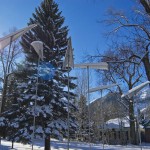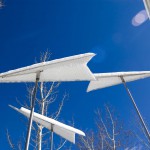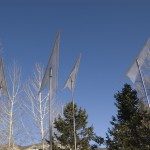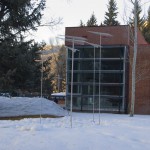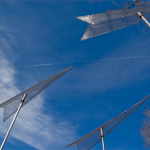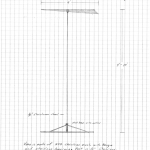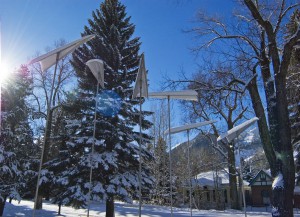
ASPEN, COLORADO – The installation called Invisible Aerovanes worked perfecting in the heavy snow conditions common in this world-renowned ski town, according to the artists Steuart Bremner & Terry Talty, who made the piece. Installed at the Red Brick Center for the Arts in Aspen, this sculpture consists of nine elements that look something like a paper airplane, arranged at heights from 3-4 meters, which normally indicate wind direction. The stainless-steel-mesh weathervanes are designed to accumulate snow and change from nearly transparent forms to soft white ones. When so formed, the weight of the snow locks the bearing, freezing the elements so they are no longer able to act as wind vanes. In this state they are simply a sculpture.
Bremner and Talty are artists who have lived and worked, together, in Colorado for more than 35 years, making temporary environmental works and permanent public art projects in their home state and internationally. Their work is experiential and often informed by the natural world. They are recent recipients of the Artist in Wilderness grant from the conservation group, Wilderness Workshop.
“We came to Aspen as guests of the Wilderness Workshop,” Bremner said, “and saw maps of the Hidden Gems project that is of current focus of the group. I was struck by the fact that there is wilderness in every direction. We came up with an idea to create an indicator that would reveal the world we were experiencing. We realized we could walk in any direction from here and arrive in protected wilderness – sometimes a long way and through country that is interesting in its own right. The idea of the indicators came from walks near the Thompson Divide and Smugglers Gulch – from experiencing the natural world and imagining how wind and snow affect this unspoiled land, which is always there, and always different.”
The Artist in Wilderness Program of the Wilderness Workshop was established in 2008, and offers one or two residencies each year to allow artists to make works inspired by the lands that WW is working to protect. Selected by a jury of regional artists and collectors, participants have worked in traditional media and now, environmental sculpture.
The Wilderness Workshop is the conservation watchdog of nearly 3 million acres of public lands in western Colorado. Using science, the law and grassroots activism, WW works to keep the White River National Forest and nearby BLM lands more or less “as is” and, where possible, to restore wildness to this nationally important landscape.


